The iPhone 6 Plus Mini-Review: Apple's First Phablet
by Joshua Ho on September 30, 2014 8:00 AM EST- Posted in
- Smartphones
- Apple
- Mobile
- iOS
- iPhone 6 Plus
Display
While the iPhone 6 Plus’ display is largely similar to the iPhone 6’s display, there are still a few areas worth talking about. The first area is resolution, which is noticeably better on the iPhone 6 Plus on close examination. In general, there’s less aliasing that is visible on the display. While text rendering in general is even better, the improved resolution is most obvious in the rotation lock symbol, which is noticeably smoother and rounder. The use of the 2208x1242 resolution with downscaling should also have a similar effect to FSAA (Full Screen Anti-Aliasing), which will reduce the effects of aliasing on the display.
Outside of simple resolution testing, we also need to test all other aspects of the display. In order to do this, we turn to SpectraCal’s CalMAN 5 with a custom workflow. As always, we use a spectrophotometer to measure color to ensure accurate results. For this review, I won’t go over viewing angles as that’s covered in the iPhone 6 review.
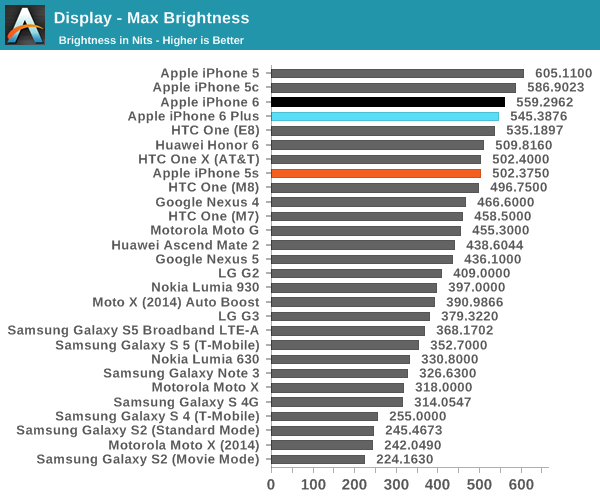
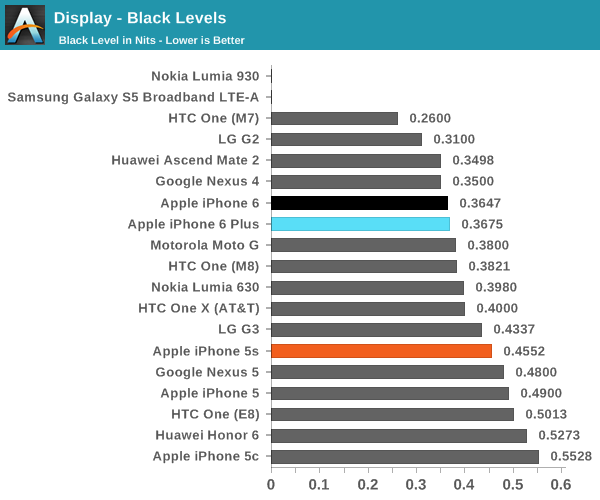
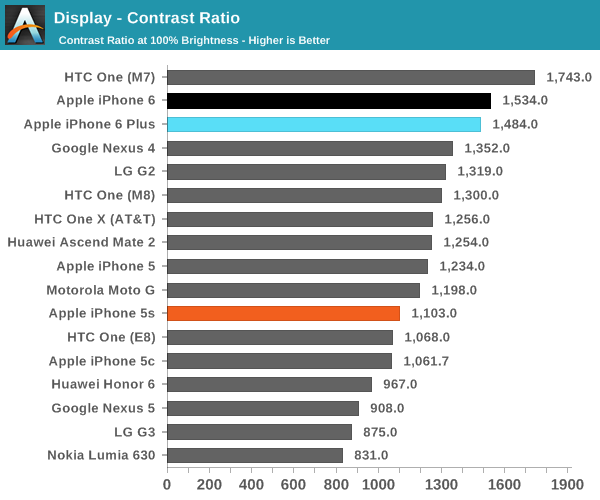
Our first test is of peak luminance and contrast. At maximum, the contrast difference between the iPhone 6 and 6 Plus is relatively small, and the difference in peak luminance is relatively small as well. I suspect that this means that Apple isn’t quite at the point where backlight luminous efficiency is rapidly falling off the way it seems to at 500+ PPI RGB LCD displays.

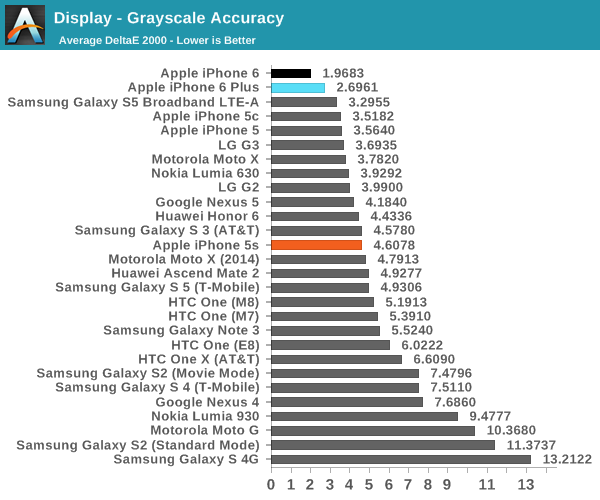
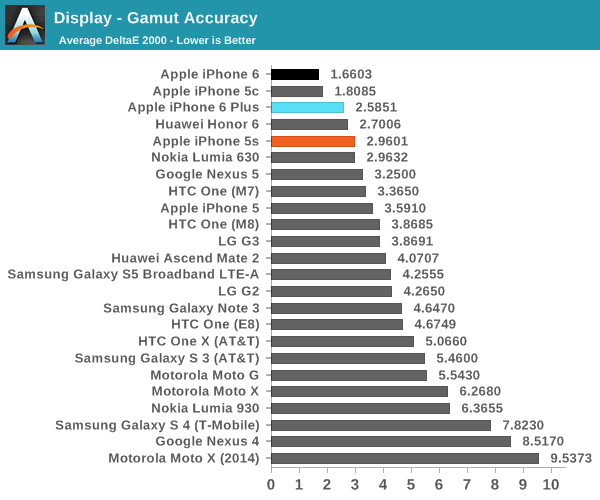
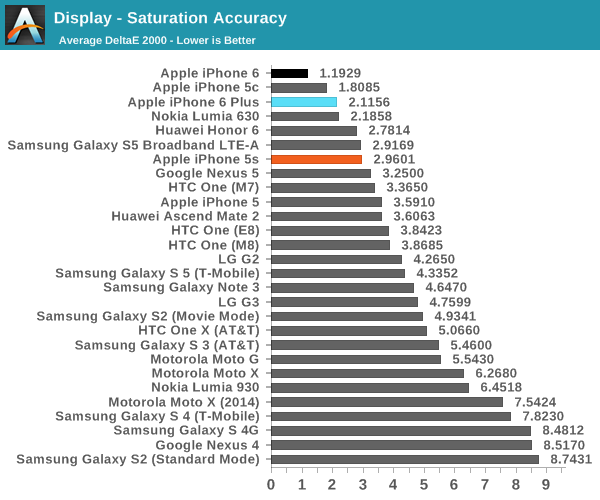
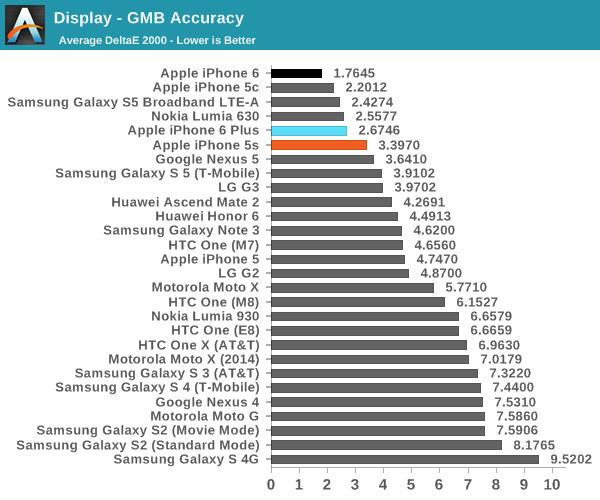
While I normally walk through each type of calibration test, there’s relatively little need in this case as the iPhone 6 Plus is close to the iPhone 6. There are some differences and the iPhone 6 is nearly perfect while the 6 Plus ends up being better than the 5s but not quite at the same level as the 6. I suspect this could be due to production variance, but these are different panels so without additional test units we can't say for certain. The iPhone 6 Plus display is quite close to the iPhone 6’s display in most regards, only larger; this is effectively as good as it gets for an LCD display.
Camera
Ultimately the change to the camera is the one difference that really sets the iPhone 6 and 6 Plus apart outside of the change in size. This one difference is optical image stabilization, or OIS. However, at first it's almost impossible to tell whether OIS is active. As someone who has used multiple cameras with OIS, this is a very odd sensation. Normally, OIS means that it's possible to see the effect of reverse accommodation in either the camera preview or while recording video, but I never saw these effects while recording video, whether in daytime or at night. In fact, I'm not even sure that video is ever optically stabilized, as seen in the videos below. I'm not sure why Apple chose to do this, as video recording is already cropped and would hide most of the odd effects that occur at the edges of the field of view when using OIS.
Putting aside OIS in video, it's obvious that the one area where OIS would be put to use is low light photography. Examining the EXIF data of low light photos, I was rather surprised to discover that in single shot mode (burst mode caps shutter speed to 1/15s) that the iPhone 6 Plus never exceeds 500 ISO. However, in order to keep pace with the iPhone 6's maximum of 2000 ISO and 1/15s exposure time, the iPhone 6 Plus drives exposure time as far as a quarter of a second, which is four times as long.
I really can't emphasize how incredible it is that Apple has pulled this off as it felt like something was wrong when I was testing low light photos as seen below. Normally, such a long exposure time entails noticeable trade-offs, but as far as I can tell motion blur is close to what I see on the iPhone 6 in low light. This seems to be the product of the multiple exposure combination that was mentioned in the keynote, and it really does work as advertised. While some benefit can be seen in the lightbox shot above, it's really in low light conditions like the photo below where we see significant benefits.
As you might expect, there's not much difference in daytime photos. I'm guessing that OIS is disabled above a certain shutter speed in order to reduce the distortion and blurriness that can come from OIS.


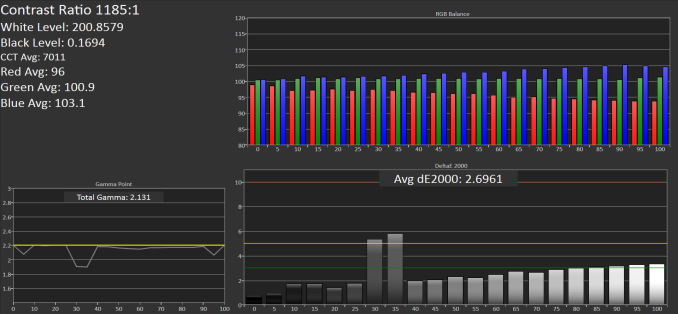
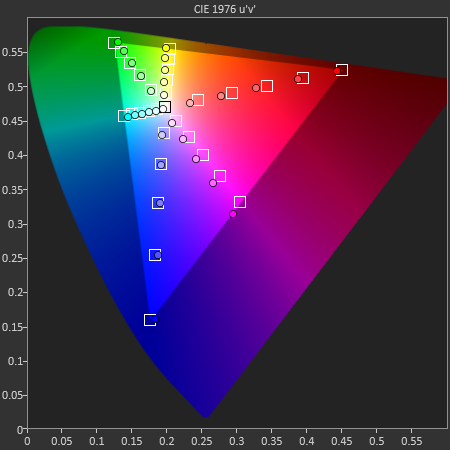
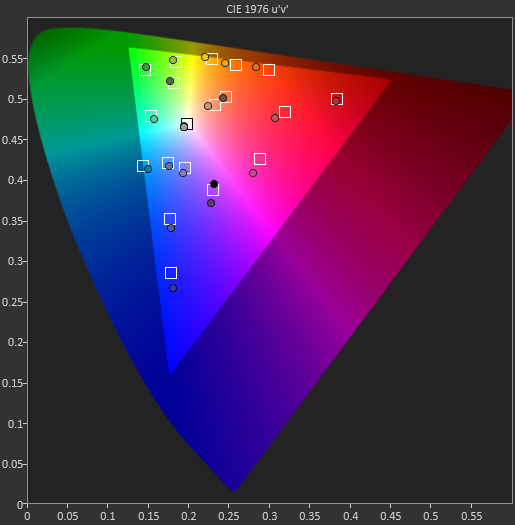






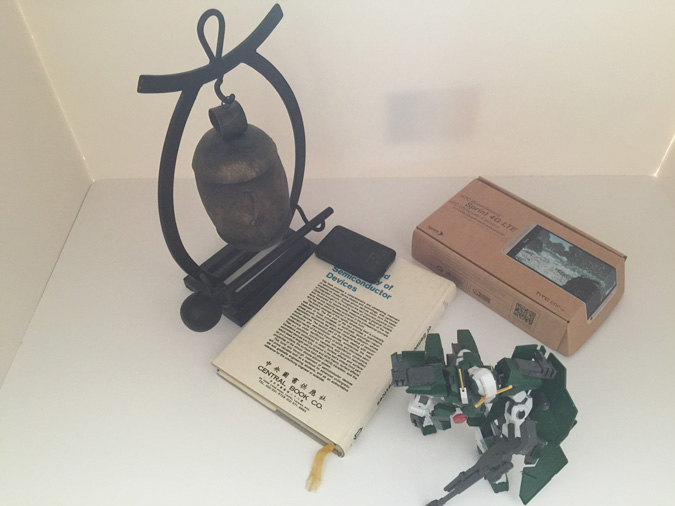






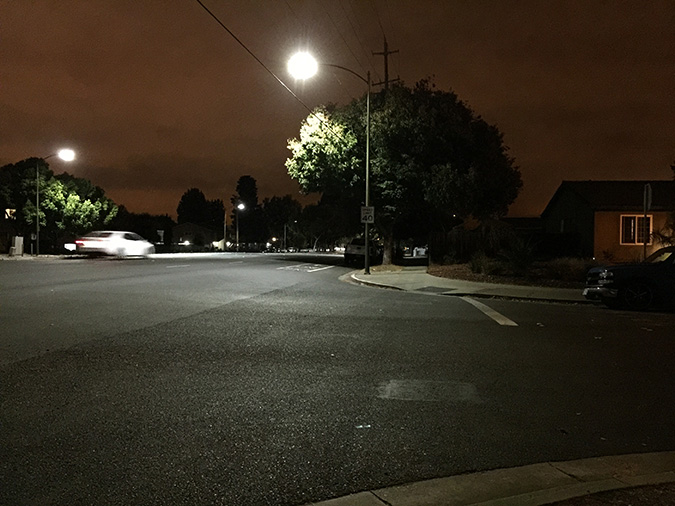






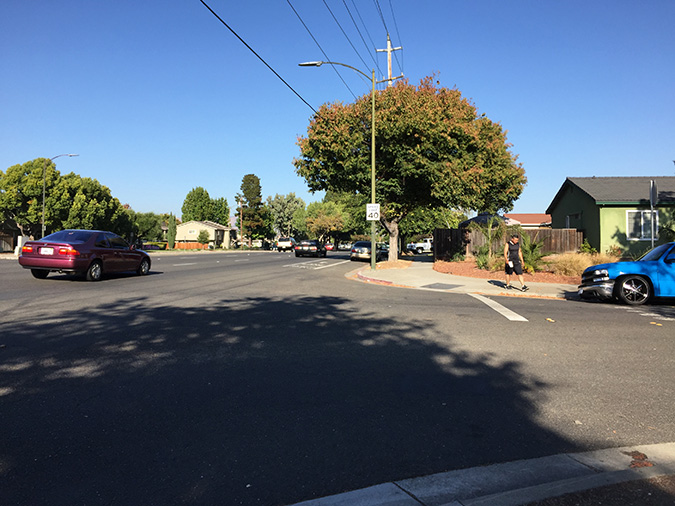








191 Comments
View All Comments
nerd1 - Wednesday, October 1, 2014 - link
Also current android flagship (with snapdragon 805) is FASTER than iPhone 6+ in terms of multithread load (which anandtech never tests for some curious reason), and their browsing performance is on par with iPhone 6+ when tested with their STOCK browser (yet anadtech only tests with chrome, which is 2X slower)Camera is simply no match. Take a look at DXOMark individual scores. iPhone 6/6+ has both lower acuity (resolution) and higher noise than galaxy S5. It got high score for autofocus, which *curiously* made the total averaged score to the top.
And apple devices are suffering greatly from lack of memory, which is even worse with 64 bit address set (which eats up 20~30% more memory). A simple test is opening multiple tabs in safari and going through them. You will see them refresh ALL THE TIME due to lack of memory.
I know iDiots can't understand this and won't listen anyway though.
ninjaroll - Wednesday, October 1, 2014 - link
Sorry, what did you say? I'm too busy enjoying using my phone and getting things done.GigaMonster - Thursday, October 2, 2014 - link
Oh we understand your cycling through tabs "test". We just know it's meaningless because it's just a dumb demo test. It doesn't reflect normal daily usage, is not a "user story" that needs to be fulfilled, and is a waste of our time to sit there cycling through tabs when we cod just be getti stuff done.val580 - Wednesday, October 1, 2014 - link
IPhone 6+ design and feel in hand is similar to galaxy note 2.The screen size and bezel are also the same.
Apple is stuck in 2012 and don't care because peope buy the product
Mugur - Thursday, October 2, 2014 - link
The conclusion that 6+ is the best phablet out there is simply ridiculous. It's like saying that the best Android tablet is HTC One Max.6+ has no phablet merit other than the screen size.
KuyaMarkEduard - Thursday, October 2, 2014 - link
WOW!alibis after excuses after exculpations!
"Unfortunately, the included charger is the same 5W charger that we've seen for years now. As a result, the iPhone 6 Plus is constrained by the relatively low maximum power that it can put out. Those that wish for faster charging should look into getting an iPad A/C adapter as the iPhone 6 Plus will charge faster when connected to it."
how-much did the rotten fruit company pay you for this review?
I know you won't reply to this, but just for the sake of argument, granting that you will, and you say that you're not making any excuses whatsoever, when Galaxy note 4 an Edge come to your hands for review, will you also defend all of the possible flaws that you may be able to discover? and also for the massive features and capabilities of the two note devices, for the sake of utmost fairness, oh well, if you really are in the first-place, and you indeed insist, will you also praise them?, and say like this, or that feature is awesome or something to that effect? or you just say that this, or that, is nothing compare to your product, but a bunch of gimmicks!
…Just a piece of advice, if you care to listen anyway, whatever you're gonna say when that time finally arrives, don't be too obvious...…
Parhel - Thursday, October 2, 2014 - link
Not sure what you're getting at, really. They were calling them out on the fact that the included wall adapter sucks, and that you can charge your phone twice as fast with an iPad adapter. A lot of iPhone users (most?) already know that and buy aftermarket A/C adapters. I know I do. It only changes the recharge time, not the performance of the phone or the benchmarks or anything else.Michał - Thursday, October 2, 2014 - link
I very much welcome the 6+. My eyesight is not what it was and I don't like the portrait size keyboard on my 5. Just a little too small. I do feel that the many senior users of iPhones will welcome this phablet model and that the large size of this segment of the market is being overlooked in many reviews. A mature market will have three sizes of phones. Small for girls, children and those with small hands. Middle size for most of the market and large size for those who have eyesight and accessibility needs short of disability. Many people like me have waited for this Iphone phablet..KuyaMarkEduard - Thursday, October 2, 2014 - link
Allright then. however, if you could wait, just a little bit longer, you then may be able to choose between Samsung's Galaxy Note4, or the Note Edge; whichever you like, and it would certainly get, a lot more of your money's worth..., just too many to enumerate!ninjaroll - Thursday, October 2, 2014 - link
Thanks KuyaMarkEduard@samsung.com!!